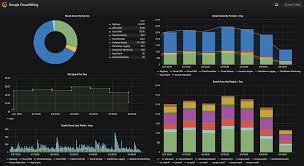Last month, Grafana Labs became the first open source provider to enter a joint development and go to market deal with AWS. But the company is still moving very much ahead with its own cloud offering as well.
The company is releasing a new version of its namesake Grafana Cloud that has the usual update of increasing throughput — in this case, for the same cost, handling five times the metrics. While this sounds like a free lunch, in actuality, as enterprises expand their cloud footprints, growing the footprint of their Grafana service at best keeps pace. The new version also adds a few more prebuilt connectors, in this case to CockroachDB (which is also in the news today, with new funding); an updated connector to MySQL, and Go. That comes in addition to a portfolio of over 40 plugins (connectors) supporting data sources such as InfluxDB; PostgreSQL; Vertica; Google BigQuery; Oracle; Elasticsearch; Kubernetes; AWS CloudWatch; Splunk; Datadog; Microsoft Azure Monitor; New Relic; and others.
The headline, however, is a free tier designed to entice new developers to kick the tires. It handles up to 10,000 metrics for Prometheus or Graphite; 50 GBytes of logs; support for up to three team members and up to 14-day retention.
By contrast, the paid Pro tier, which greatly expands capacity to 15,000 metrics for up to 90 days retention; 100 GBytes of logs that are retained for 30 days; reporting capabilities (with support for PDF exports); and more advanced authentication.
All this comes to an open source project that is, in effect, the little observability visualization engine that could. As we noted last month, Grafana has become one of the most popular, if not the most popular, visualization engine for the data key to observability: event logs, metrics for key attributes, and traces showing end-to-end journey that are the answer for microservices what application performance management was to traditional monolithic applications. It provides a more open alternative to Elasticsearch’s Kibana because it not only has connectors to a wide variety of data sources, but also can plug in to vendor monitoring engines that otherwise overlap or compete with Prometheus. Grafana is also tapping into a hot market, as a look at rival Elastic’s performance shows.
Grafana also offers an enterprise version for customers to implement on their own. The Grafana Cloud is used for collecting, analyzing, and tracking alerts on Prometheus and Loki logs. The new Pro and free tiers are available now.



